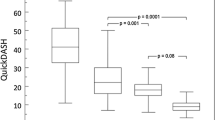Abstract
Background
The purpose of this study was to assess whether there is a threshold Disability of Arm, Shoulder and Hand (DASH) score among patients with common hand diagnoses that corresponds with an estimated diagnosis of clinical depression.
Methods
Two hundred sixty-nine patients with one of five common upper extremity disorders completed a measure of upper extremity-specific disability (QuickDASH or DASH) and a questionnaire assessing depressive symptoms (Patient Health Questionnaire (PHQ) or Center for Epidemiologic Studies Depression scale (CES-D). A receiver operating characteristic (ROC) analysis of the discriminatory value of a threshold DASH score for an estimated diagnosis of clinical depression was assessed. The threshold DASH score with the highest positive predictive value for an estimated diagnosis of clinical depression was selected. In bivariate analysis, the association between demographic factors, disease factors, and an estimated diagnosis of clinical depression was examined.
Results
The area under the ROC curve for a threshold DASH value diagnostic of an estimated diagnosis of clinical depression was 0.75, indicating clinical usefulness for a threshold DASH score as a screening test for depression. The highest positive predictive value of 72 % occurred at a threshold QuickDASH/DASH score of 55. In bivariate analysis, only diagnosis and years of education were significantly different between patients with and without an estimated diagnosis of clinical depression.
Conclusion
A DASH score of 55 or greater in patients with common upper extremity disorders has an acceptable area under the curve and positive predictive value for an estimated diagnosis of clinical depression.
Level of Evidence: Level 3, diagnostic study

Similar content being viewed by others
References
Aasheim T, Finsen V. The DASH and the QuickDASH instruments. Normative values in the general population in Norway. J Hand Surg Eur. 2013.
Angst FGJ, Drerup S, Flury M, Schwyzer HK, Simmen BR. How sharp is the short QuickDASH? A refined content and validity analysis of the short form of the disabilities of the shoulder, arm and hand questionnaire in the strata of symptoms and function and specific joint conditions. Qual Life Res. 2009;18(8):1043–51.
Fan J, Upadhye S, Worster A. Understanding receiver operating characteristic (ROC) curves. CJEM. 2006;8(1):19–20.
Hanley JA, McNeil BJ. The meaning and use of the area under a receiver operating characteristic (ROC) curve. Radiology. 1982;143(1):29–36.
Hwang RW, Ring D. Pain and disability related to osteoarthrosis of the trapeziometacarpal joint. J Hand Microsurg. 2011;3(2):63–5.
IfWaH. The QuickDASH outcome measure, a faster way to measure upper-extremity disability & symptoms. Information for Users. Institute for Work & Health. 2006.
Katz P. Function, disability, and psychological well-being. Adv Psychosom Med. 2004;25:41–62.
Kroenke K, Spitzer RL, Williams JB. The PHQ-9: validity of a brief depression severity measure. J Gen Intern Med. 2001;16(9):606–13.
Little CA, Williams SE, Puzanovova M, Rudzinski ER, Walker LS. Multiple somatic symptoms linked to positive screen for depression in pediatric patients with chronic abdominal pain. J Pediatr Gastroenterol Nutr. 2007;44(1):58–62.
Manea L, Gilbody S, McMillan D. Optimal cut-off score for diagnosing depression with the Patient Health Questionnaire (PHQ-9): a meta-analysis. CMAJ. 2012;184(3):E191–6.
Metz CE. Basic principles of ROC analysis. Semin Nucl Med. 1978;8(4):283–98.
Niekel MC, Lindenhovius AL, Watson JB, Vranceanu AM, Ring D. Correlation of DASH and QuickDASH with measures of psychological distress. J Hand Surg [Am]. 2009;34(8):1499–505.
Ohayon MM, Schatzberg AF. Using chronic pain to predict depressive morbidity in the general population. Arch Gen Psychiatry. 2003;60(1):39–47.
Orallo J. ROC curves for regression. Patt Recogn. 2013;46(12):3395–411.
Radloff LS. The CES-D scale: a self-report depression scale for research in the general population. Appl Psychol Meas. 1977;1:385–401.
Ring D, Kadzielski J, Fabian L, Zurakowski D, Malhotra LR, Jupiter JB. Self-reported upper extremity health status correlates with depression. J Bone Joint Surg Am. 2006;88(9):1983–8.
Roh YH, Lee BK, Noh JH, Oh JH, Gong HS, Baek GH. Effect of depressive symptoms on perceived disability in patients with chronic shoulder pain. Arch Orthop Trauma Surg. 2012;132(9):1251–7.
Roh YH, Noh JH, Oh JH, Baek GH, Gong HS. To what degree do shoulder outcome instruments reflect patients’ psychologic distress? Clin Orthop Relat Res. 2012;470(12):3470–7.
Zich JM, Attkisson CC, Greenfield TK. Screening for depression in primary care clinics: the CES-D and the BDI. Int J Psychiatry Med. 1990;20(3):259–77.
Zwaigenbaum L, Szatmari P, Boyle MH, Offord DR. Highly somatizing young adolescents and the risk of depression. Pediatrics. 1999;103(6 Pt 1):1203–9.
Acknowledgments
Conflict of Interest
David Ring has received consultancy fees from Wright Medical and Skeletal Dynamics. David Ring has received a speaker honorarium from AO North America and AO International. David Ring has received royalties from Wright Medical. David Ring owns stock in Illuminos. Stein J. Janssen received research grants from Stichting Anna fonds and Stichting Michael van Vloten fonds, both not related to the submitted work. Jeroen Molleman declares that he has no conflict of interest. Celeste L. Overbeek declares that she has no conflict of interest.
Statement of Human and Animal Rights
All procedures followed were in accordance with the ethical standards of the responsible committee on human experimentation (institutional and national) and with the Helsinki Declaration of 1975, as revised in 2008 [5].
Statement of Informed Consent
The study was approved by our institutional review board and a waiver of informed consent was obtained.
Author information
Authors and Affiliations
Corresponding author
About this article
Cite this article
Molleman, J., Janssen, S.J., Overbeek, C.L. et al. A threshold disability score corresponds with an estimated diagnosis of clinical depression in patients with upper extremity disease. HAND 10, 168–172 (2015). https://doi.org/10.1007/s11552-014-9686-y
Published:
Issue Date:
DOI: https://doi.org/10.1007/s11552-014-9686-y



